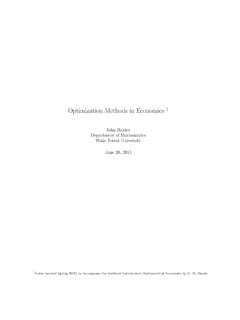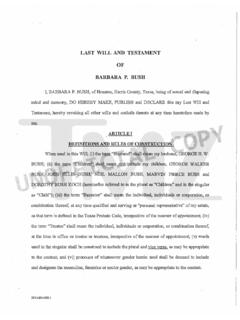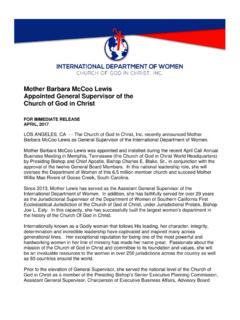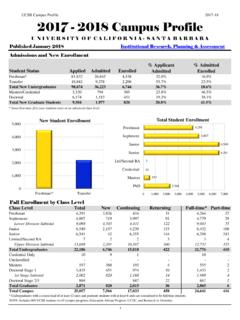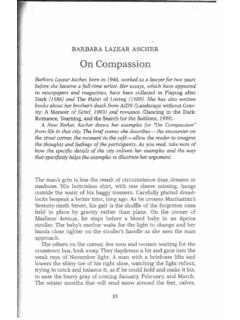Transcription of The Story of Grutter v. Bollinger Affirmative Action Wins
1 The Story of Grutter v. Bollinger : Affirmative Action Wins Wendy Parker1 In 1996, at the age of forty-three, barbara Grutter decided a career change was in order. She applied to a nearby law school, the University of Michigan Law School, with the hopes of becoming a health care attorney. A white woman, she had graduated from Michigan State University eighteen years before with a grade point average. She was raising two sons (then seven and ten) and running her own small business as a health care information technology consultant in Plymouth, She had recently scored a 161 on the LSAT, placing her in the 86th percentile. Grutter made it onto the Michigan waiting list, but not its classrooms. The rejection initially surprised her, but her surprise turned to dismay when she recalled a recent article in a Detroit The article indicated that minorities admitted to Michigan had lower test scores and grades than admitted whites.
2 Believing Michigan Law School had discriminated against her on the basis of her race, she eventually agreed to become the name plaintiff in a suit brought by the Center for Individual Rights ( CIR ) against the law school s race conscious admission policies. CIR was engaged in a well-financed litigation strategy to have Justice Lewis Powell s opinion in Bakke v. Regents of University of California declared legally That opinion had endorsed diversity as a reason for states to engage in racial preferences in university admissions. When CIR filed suit on behalf of Grutter , its goal seemed in sight. It had already won a significant victory in a similar case filed on behalf of Cheryl Hopwood, a white woman denied admission to The University of Texas School of Law.
3 CIR had also recently filed two other similar suits on behalf of other white women: Katuria Smith s suit against the University of Washington Law School and Jennifer Gratz s suit against the University of Michigan College of Literature, Science, and the Arts. 1 Thanks to Marvin Krislov, Miranda Massie, Michael Olivas, Wilson Parker, Mike Selmi, and Ted Shaw for their many very helpful comments. I would especially like to thank barbara Grutter for all her time and effort in commenting on this book chapter. All errors, of course, are my own. 2 Email message from barbara Grutter to author (June 14, 2006). 3Id.; Mark Clayton, The Woman Behind the Law School Admissions Suit, Christian Science Monitor, April 3, 2001, at 14.
4 4438 265 (1978). THE Story OF Grutter V. Bollinger 2 Public opinion appeared to favor CIR s goal as well. In November 1996 voters in California had passed Proposition 209, which broadly prohibited race conscious activity by the state. Two years later, voters in Washington would pass a similar measure. CIR seemed unstoppable: both the judiciary and voters appeared on its side. Affirmative Action supporters were clearly losing public opinion and in the courts. Yet, the tide came to favor Affirmative Action . In Grutter v. Bollinger , the Supreme Court affirmed that diversity could be a legally legitimate rationale for Affirmative Action , and validated Michigan s approach to deciding who gets admitted to the law Further, state law prohibitions on race-based Affirmative Action have come to a standstill.
5 Here I tell the Story of what ended up stopping CIR and how and why Affirmative Action survived at least for now. The Story takes us not just to why Grutter never attended law school, but also to the students who benefited from race-conscious admissions. On a larger scale, the Story is one of diversity gathering public support, and the Supreme Court constitutionalizing that public acceptance and allowing voluntary integration. Yet, the Story also raises the possibility that diversity s survival will prove transitory. Race-Based Affirmative Action in Higher Education: The Beginnings College admissions has rarely been just about meeting objective Harvard, for example, adopted in 1905 the College Entrance Examination Board to open admissions beyond those attending Eastern prep schools.
6 By 1922 Harvard alumni and administrators feared, however, that admissions had gotten too open for one group in particular Jews. The objective test had given Jews more than a fifth of the seats in Harvard s freshman class, and Harvard, like Yale and Princeton, feared a Hebrew Invasion. Harvard President A. Lawrence Lowell tried, unsuccessfully, to limit Jews to 15% of the enrollment through an explicit quota. Instead, the three colleges decided to define merit as more than a test score and turned to test the character of applicants. Now personal essays and interviews were required, and applications were asked about Race and Color, Religious Preference, Maiden Name of Mother, Birthplace of Father, and What change, if any, has been made since birth in your own name or that of your father?
7 (Explain fully). 7 These very effective anti-Jewish policies eventually gave way at the Ivy Leagues in the 1960s. What remained, however, was the notion that admission could mean more than test scores. Some schools, but not all, used that idea in the 1960s to expand their student body to groups historically under-represented. Schools began an explicit quest to increase their enrollment of African Americans and, to a lesser extent, Asian Americans, Latinos, and Native Americans. To admit students from these groups, the schools decreased the importance of test 5539 306 (2003). 6 See generally Jerome Karabel, The Chosen: The Hidden History of Admission and Exclusion at Harvard, Yale, and Princeton 77-136 (2005); Malcolm Gladwell, Getting In: The social logic of Ivy League admissions, The New Yorker, Oct.
8 10, 2005, at 80-86. 7 See Gladwell, supra note 6, at 82. 3 WENDY PARKER scores, prep school attendance, and financial need thereby allowing minority students to gain admission. The colleges opened up admissions mainly in the name of increasing Negro leadership, but also to compensate for past, societal injustices to the groups and to foster institutional The methods were relatively successful. Only around 200 African Americans enrolled in historically white law schools in 1964; that number increased to 1,700 by Other schools at the time, particularly Southern ones, took a quite different approach to minority enrollment: they admitted African Americans students only under court order. For example, rather than enrolling both African American and white school children in the same school, Prince Edwards County, Virginia ordered its schools closed.
9 The schools remained closed for five years, until the Supreme Court ordered them Matters were equally problematic at the college level. It took not only a court order but 23,000 soldiers (three times the population of Oxford), including the Marines and Air Force, to enroll James Meredith at Ole Miss and at a cost of two The school was far from pleased with the order to admit Meredith, and responded with racially neutral admission standards designed to forestall minority These two different approaches to minority enrollment one struggling against it, the other struggling for it were legally connected by the Fourteenth Amendment and the Civil Rights Act of 1964, both of which prohibit discrimination on the basis of race and ethnicity. If schools could not refuse admission because of the race of the student a principle of Brown v.
10 Board of Education could the schools consider race to admit a minority student into a historically white institution? In other words, did Brown s principles also mean that voluntary Affirmative Action plans to increase minority enrollment were as unconstitutional as schools reserved solely for white students? In 1974 Allan Bakke prominently brought that issue to the courts. He sued the University of California Medical School at Davis ( Davis ) in state court, after he was twice rejected and a sympathetic admissions officer told him of a special admissions program for minority students. Davis specifically set aside 16 of its 100 admissions slots for African Americans, Asian Americans, Latinos, and Native Americans, a set aside reflecting California s minority population.
